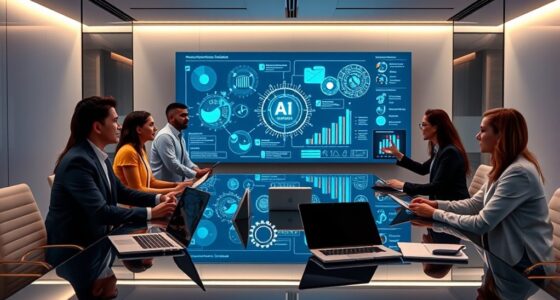AI and large language models are revolutionizing your daily office work by automating routine tasks, improving communication, and boosting productivity across departments. From drafting emails and summarizing meetings to enhancing customer support and content creation, these tools help you focus on strategic priorities. They streamline workflows, support data analysis, and facilitate smarter decision-making. Staying ahead means understanding how these innovations can transform your work environment—continue exploring to uncover detailed insights.
Key Takeaways
- LLMs automate routine tasks like drafting emails and generating reports, saving time and increasing productivity.
- AI-powered virtual assistants understand complex queries, aiding in scheduling, data management, and decision-making.
- Advanced chatbots enhance customer support with personalized, 24/7 AI-driven interactions.
- AI tools analyze data in real-time, supporting quick insights and proactive problem resolution.
- Integration of LLMs reshapes workflows, fostering collaboration and allowing humans to focus on strategic activities.
The Rise of Large Language Models in Office Tasks

The rise of large language models (LLMs) has transformed everyday office tasks by making communication, content creation, and customer support more efficient. You now rely on LLM-powered virtual assistants that understand complex queries and respond accurately. Advanced chatbots, like those built with GPT-4, provide personalized support for customers and internal teams. Email and messaging are streamlined through automated drafting, ensuring professionalism and clarity. Meeting summaries generated by AI help you quickly grasp key points and decisions. AI-driven automation further reduces the manual effort involved in routine tasks, freeing up time for strategic planning. LLMs also break language barriers with real-time translations, enabling seamless multilingual communication. Additionally, the integration of data analytics helps optimize workflows and improve decision-making processes. These innovations save time, reduce errors, and improve overall workflow, allowing you to focus on strategic tasks while AI handles routine interactions and content management. Additionally, understanding the role of bedroom decor can help you visualize a space that promotes comfort and relaxation in personal or professional settings.
Productivity Gains Across Different Departments

AI-driven tools are transforming departmental workflows by enabling teams to work more efficiently and creatively. In administrative roles, AI helps you write 59% more documents per hour, speeding up report and proposal creation. Programmers can code 126% more projects weekly, boosting software development productivity. Operations teams benefit from streamlined processes, reducing routine tasks and freeing time for strategic initiatives. Departments focused on innovation can explore new ideas more rapidly, as AI automates repetitive work and enhances collaboration. This shift allows your team to move from reactive to proactive work, increasing overall departmental efficiency. As AI integrates into daily routines, expect productivity to grow remarkably, aligning with studies estimating decades of long-term gains. Additionally, understanding personality traits of colleagues and partners can further improve teamwork and communication in an AI-augmented workplace. Incorporating organizational flexibility can also help teams adapt quickly to changing technological environments, maximizing the benefits of AI implementation. Moreover, leveraging AI analytics tools can identify emerging opportunities and optimize resource allocation for even greater efficiency. Implementing practices such as decluttering digital files can further streamline workflows and reduce cognitive overload, enhancing overall productivity. Leveraging insights from nutritional science can optimize workplace wellness initiatives and improve employee health outcomes.
Transforming Customer Support and IT Services

How is artificial intelligence reshaping customer support and IT services? AI is revolutionizing how you handle customer interactions and IT operations. By 2025, 95% of customer interactions will be powered by AI, enabling personalized, 24/7 support that reduces response times and costs. Customers increasingly see AI as empathetic, especially with advanced agents replacing basic chatbots. In IT, AI enables predictive maintenance by analyzing data to prevent issues before they occur. Natural language processing improves interaction quality, while automation handles routine tasks, freeing your team for complex problems. AI also enhances security by detecting threats early. As AI adoption grows, it offers more sophisticated capabilities, creating a seamless blend of automation and human support that boosts efficiency, customer satisfaction, and security. The integration of Personality Test insights can further improve customer engagement strategies. Support hours for AI services may vary depending on provider and region, making it important to stay informed about service availability and operational schedules. Additionally, AI-driven analytics are increasingly used to optimize workflows and decision-making processes, further transforming the workplace. Moreover, incorporating specialized knowledge helps tailor AI solutions to specific industry needs, ensuring more effective outcomes. Furthermore, leveraging industry-specific data can improve the accuracy and relevance of AI responses, leading to better customer experiences.
Enhancing Creativity and Content Creation

Artificial intelligence is transforming the way you approach creativity and content creation by providing powerful tools that generate ideas, drafts, and personalized material at unprecedented speeds. Large language models (LLMs) help you brainstorm by analyzing vast data sets, suggesting diverse ideas, and overcoming creative blocks with automated suggestions. They support collaborative workflows by refining concepts through real-time input and iterative feedback. LLMs can mimic different styles, fueling innovation in content strategies and artistic approaches. They quickly produce first drafts for articles, marketing copy, or social media posts, maintaining tone and relevance. Personalization is enhanced as LLMs adapt content to individual preferences and cultural nuances, boosting engagement. Moreover, incorporating software quality assurance best practices ensures these AI tools operate reliably and securely within your workflows. This automation frees you to focus on refining ideas, pushing creative boundaries, and exploring new formats without burnout. Additionally, understanding the floating on water concept can inspire new ways to visualize and present your content, making it more engaging and dynamic. Exploring content diversity can further broaden your creative horizons and reach wider audiences. To ensure consistent quality, applying key traits of successful software quality assurance engineers principles can help detect and resolve issues early, maintaining high standards in your AI-driven projects. Recognizing the importance of data integrity can further optimize the performance and trustworthiness of these systems in your creative processes.
Streamlining Administrative and Routine Work

By automating routine administrative tasks, you can substantially boost office efficiency. LLMs generate summaries and detailed reports from large datasets, saving you time on manual data entry and analysis. They extract structured information from unstructured documents like PDFs, streamlining data handling tasks. Automated report generation accelerates workflows in finance, legal, and admin departments, reducing delays. Custom chatbots provide instant answers by accessing proprietary databases, improving document retrieval. LLMs also assist with scheduling, managing calendars, and sending reminders, easing daily routines. They draft and reply to routine emails, freeing you from repetitive communication. Integration with existing software helps organize tasks, prioritize requests, and track progress in real time. Moreover, understanding merchant services and their associated risks can help tailor AI solutions to ensure secure and compliant operations. Recognizing the importance of data security is crucial when implementing AI tools to protect sensitive information. For example, awareness of pop culture updates can enhance engagement when designing interactive AI interfaces. Overall, these tools help you focus on strategic activities while handling routine work efficiently.
Impact on Software Development and Coding

The integration of large language models (LLMs) into software development has notably boosted productivity and efficiency. You can automate code generation, cutting manual coding time by up to 30%, and generate boilerplate code quickly, letting you focus on complex logic. Features like code completion and suggestions speed up your work while reducing syntax errors. Automated debugging tools help identify bugs faster and propose fixes, decreasing troubleshooting time. When integrated with IDEs, LLMs support seamless workflows without switching contexts, increasing your productivity.
| Benefit | How It Helps | Example |
|---|---|---|
| Increased Productivity | Automates routine coding tasks | Generates boilerplate code |
| Improved Code Quality | Enforces standards, suggests improvements | Automated code reviews |
| Learning Support | Acts as an interactive tutor | Explains unfamiliar concepts |
| Complex Problem Solving | Breaks down tasks, offers solutions | Refactors code for performance |
| Role Transformation | Promotes higher-level focus | Facilitates rapid prototyping |
Financial Analysis and Data Processing With AI

Harnessing AI for financial analysis and data processing transforms how institutions interpret vast and complex data sets. With LLMs, you can analyze unstructured data quickly, generating valuable insights that inform decision-making. These models excel at summarizing intricate financial reports, saving you time and reducing errors. They also recognize patterns in data, helping predict stock movements and identify risks efficiently. LLMs can augment datasets, improving forecasts and risk assessments. In financial statement analysis, they outperform human analysts in earnings predictions and provide narrative insights into future performance. Their capabilities extend to evaluating risks, detecting fraud, supporting compliance, and developing investment strategies. By leveraging advanced contextual understanding and transfer learning, LLMs enhance your ability to analyze financial data, supporting smarter decisions and strategic planning. Furthermore, ongoing advancements in training techniques and multimodal data fusion continue to expand their potential in financial applications, making them even more integral to modern finance workflows.
Challenges and Limitations of AI Adoption

Adopting AI in the workplace presents several significant challenges that can hinder its effective implementation. First, data quality and availability are critical; many organizations struggle with ensuring data integrity, while biases in data can lead to inaccurate results and ethical concerns. Second, integrating AI into existing IT systems remains complex, often requiring significant infrastructure updates. Third, privacy and security pose substantial risks, with potential data breaches and low public trust—79% of Americans distrust AI’s use. Fourth, talent shortages hinder progress; 68% of leaders find it hard to find qualified AI professionals, and many employees need new skills. These factors collectively slow down AI adoption and demand strategic solutions to overcome these limitations. Furthermore, organizations must also consider the rapidly evolving regulatory landscape surrounding AI, which can introduce additional compliance challenges.
Preparing the Workforce for an AI-Driven Future

To thrive in an AI-driven workplace, you need to develop new skills and adapt to organizational changes. Embracing continuous learning and training is essential as AI transforms job roles and business strategies. By proactively preparing, you can stay competitive and secure your future in this evolving environment. Global job loss estimates indicate that 300 million jobs could be lost worldwide due to AI, underscoring the importance of skill upgrades and adaptability.
Developing AI Skills
Preparing the workforce for an AI-driven future requires proactive efforts to develop essential skills, as many employees recognize the importance of formal training to effectively utilize AI technologies. You should focus on key areas that boost AI adoption and bridge the skills gap. Consider these priorities:
- Building in-demand roles like prompt engineers, AI ethicists, and machine learning engineers.
- Implementing extensive training programs to upskill employees impacted by AI.
- Promoting adaptability, as 71% of workers are willing to change roles and skills.
- Fostering collaboration with educational institutions and industry partners to prepare for emerging professions. Aligning education systems with industry needs is crucial to ensure the workforce remains adaptable and equipped for the evolving skills economy.
Embracing Organizational Change
As organizations integrate AI into their operations, cultivating a culture that embraces change becomes essential. Over 90% of companies plan to boost AI investments within three years, requiring you to foster adaptability and openness. While 87% of leaders see AI positively impacting operations, employee fears persist—30% worry about job obsolescence by 2025, especially among younger workers. Addressing these concerns through transparent communication and ongoing learning is critical. Leaders must actively champion AI adoption, investing in infrastructure and talent, and promoting cross-functional collaboration. Beyond skills, you need to redesign roles to leverage human strengths like creativity and critical thinking. Building an ethical framework and clear governance ensures trust and security. Embracing change with transparency and support will help your organization thrive in an AI-driven future.
Future Trends and Opportunities With LLMS

Future trends in large language models (LLMs) are poised to transform office workflows through technological innovations and expanding capabilities. As these models evolve, you’ll see:
- Multimodal fusion, enabling analysis of text, images, audio, and video for all-encompassing insights.
- Domain-specific models like Med-PaLM and BloombergGPT, offering higher accuracy in specialized fields.
- Autonomous agents that make decisions and interact with tools independently, streamlining tasks.
- Improved cross-language support, breaking down global communication barriers.
These advancements will boost operational efficiency, with autonomous tools handling workflows, real-time reasoning enhancing decision-making, and AI-driven applications embedding across industries. By 2028, expect a significant shift toward more accessible, specialized, and collaborative AI solutions shaping your daily work environment.
Frequently Asked Questions
How Secure Are AI Tools in Handling Sensitive Office Data?
AI tools handling sensitive office data aren’t fully secure yet. You risk exposing private information through data leaks, prompt injections, or data poisoning. Employees might misuse tools or mishandle data, increasing breach chances. Security measures lag behind AI adoption, making breaches costly and time-consuming to contain. To protect sensitive data, you should implement robust security frameworks, train employees properly, and ensure compliance with data regulations.
What Training Is Needed for Employees to Effectively Use LLMS?
Imagine opening new potential—your training shapes this journey. To use LLMs effectively, you need a solid grasp of their fundamentals and AI literacy. Engage in regular training sessions, participate in feedback loops, and learn about data privacy and ethics. With leadership support and personalized learning paths, you’ll develop the skills to harness LLMs confidently, making your daily work more innovative and aligned with organizational goals.
How Do AI Tools Impact Remote and Hybrid Work Environments?
You see AI tools transforming remote and hybrid work by making collaboration smoother and boosting productivity. They automate scheduling, reporting, and data analysis, saving you time and reducing friction. These tools also offer real-time transcription and support, helping you stay connected and efficient. As a result, you gain more flexibility, autonomy, and cost savings, while organizations benefit from streamlined workflows and better decision-making in a changing work landscape.
Are There Ethical Concerns With AI Automation Replacing Jobs?
You’re right to be concerned about the ethical issues of AI replacing jobs. Automation can threaten worker dignity and fairness, especially for low-skilled and entry-level roles. It’s vital that companies and policymakers prioritize transparent practices, re-skilling programs, and social safety nets. By doing so, you help guarantee that technological progress benefits everyone, minimizing social inequalities and supporting displaced workers in shifting to new opportunities.
How Will AI Adoption Influence Office Culture and Collaboration?
You’ll notice AI adoption shaping your office culture and collaboration in big ways. When organizations adopt AI with clear strategies, employees feel more engaged and see improvements in teamwork. However, tensions and conflicts can arise if AI is introduced unevenly or without proper leadership. Overall, AI can boost innovation and streamline workflows, but it also requires careful management to foster a positive environment and assure smooth cooperation among teams.
Conclusion
Imagine AI in the office as a skilled co-pilot, guiding you through the skies of daily work. With LLMs transforming tasks, boosting productivity, and opening new creative horizons, you’re flying higher than ever. Embrace these tools now, but stay alert to challenges ahead. By harnessing AI’s potential today, you set course for a future where your work feels lighter, smarter, and more innovative—ready to navigate whatever horizon comes next.









